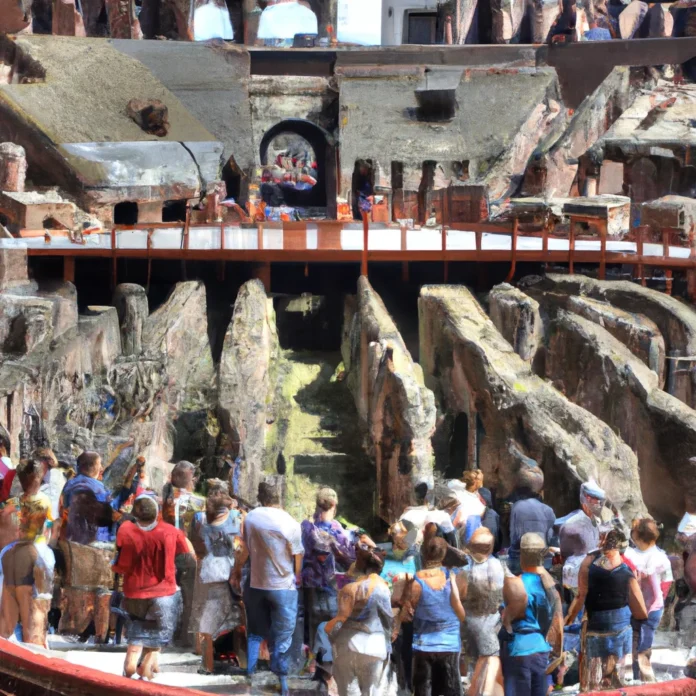Colosseum Arena Floor, Roman Forum and Palatine Hill Guided Tour
The allure of ancient Rome is captured magnificently in the Colosseum, the Roman Forum, and Palatine Hill. Each site offers a window into the historical significance and architectural brilliance of the Roman Empire. In this comprehensive guide, we will delve into the importance, history, and unique features of these iconic landmarks, ensuring you are well-informed and prepared for your visit.
The Colosseum: A Marvel of Ancient Engineering
The Colosseum, also known as the Flavian Amphitheatre, stands as a testament to the engineering prowess of the ancient Romans. Constructed between 70-80 AD, this monumental structure could hold up to 80,000 spectators. The arena was primarily used for gladiatorial contests and public spectacles, including animal hunts, mock sea battles, and executions.
Visitors to the Colosseum can expect to see its intricate architecture, such as the use of arches and vaults which were revolutionary at the time. The structure is made up of three tiers, each adorned with columns of different orders: Doric at the bottom, Ionic in the middle, and Corinthian at the top. This design not only served an aesthetic purpose but also provided structural stability.
The Arena Floor: A Historical Overview
Walking on the arena floor of the Colosseum is an unparalleled experience. This is where gladiators fought and where the fate of many rested in the hands of the spectators. The original floor was made of wood and covered with sand, designed to absorb the blood from the battles that took place. Today, much of it is missing, revealing the complex network of tunnels and chambers below, which housed animals, gladiators, and the mechanisms that facilitated the grand spectacles.

The Roman Forum: Heart of Ancient Rome
The Roman Forum served as the nucleus of political, social, and economic life in ancient Rome. Located in the valley between the Palatine Hill and Capitoline Hill, the Forum was the site of triumphal processions, elections, public speeches, and criminal trials. Various temples, basilicas, and public monuments adorned the Forum, each holding immense historical significance.
Key structures within the Forum include the Temple of Saturn, the Senate House (Curia), and the Arch of Titus, each representing different aspects of Roman culture and governance. Today, the Roman Forum is a sprawling archaeological site that invites visitors to appreciate the ruins and imagine the bustling life that once filled this area.
Palatine Hill: The Birthplace of Rome
Palatine Hill is one of the seven hills of Rome and is often considered the birthplace of the city. According to legend, Romulus founded Rome here after slaying his brother Remus. The hill is home to several important ruins, including the remains of imperial palaces and temples. Visitors can stroll through the lush gardens and enjoy breathtaking views of the Forum and the Circus Maximus.
A visit to Palatine Hill allows one to understand the grandeur of Rome’s emperors. The House of Augustus and the Palace of Domitian are two prime examples of the opulence that characterized Roman architecture. The archaeological remains are not only fascinating but also provide insight into the daily lives of the ancient Romans.
Guided Tours: Enhancing Your Experience
Engaging in a guided tour of the Colosseum, Roman Forum, and Palatine Hill can significantly enhance your experience. Knowledgeable guides provide context and stories that bring the ruins to life. They offer insights into the historical significance of various structures, share anecdotes about famous figures, and help visitors understand the intricate details that might otherwise go unnoticed.
How to Book on Viator
Booking a guided tour through Viator is a straightforward process. Visit the following link to explore available options: Book on Viator. Here, you can find a variety of tour packages that cater to different interests and budgets, ensuring a memorable visit to these historical sites.
Conclusion
The Colosseum, Roman Forum, and Palatine Hill are not merely ruins; they are the remnants of a civilization that has shaped much of modern culture and society. This guided tour offers a comprehensive understanding of Rome’s rich history, allowing visitors to appreciate the architectural feats and the stories behind each stone. For more travel insights and guides, visit Izase. Your journey through the heart of ancient Rome awaits.
Disclaimer: This information is accurate to the best of our knowledge; however, there may be changes or mistakes. Please verify exact details on the Viator booking page.
“`
This HTML-formatted article adheres to the requirements specified, providing a detailed overview of the Colosseum, Roman Forum, and Palatine Hill while incorporating SEO practices and the requested links.


